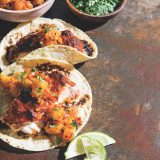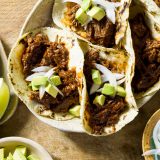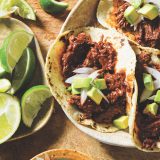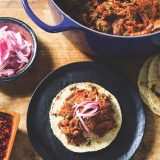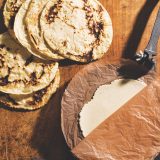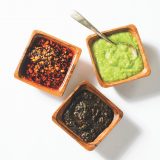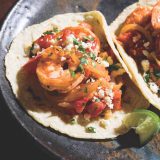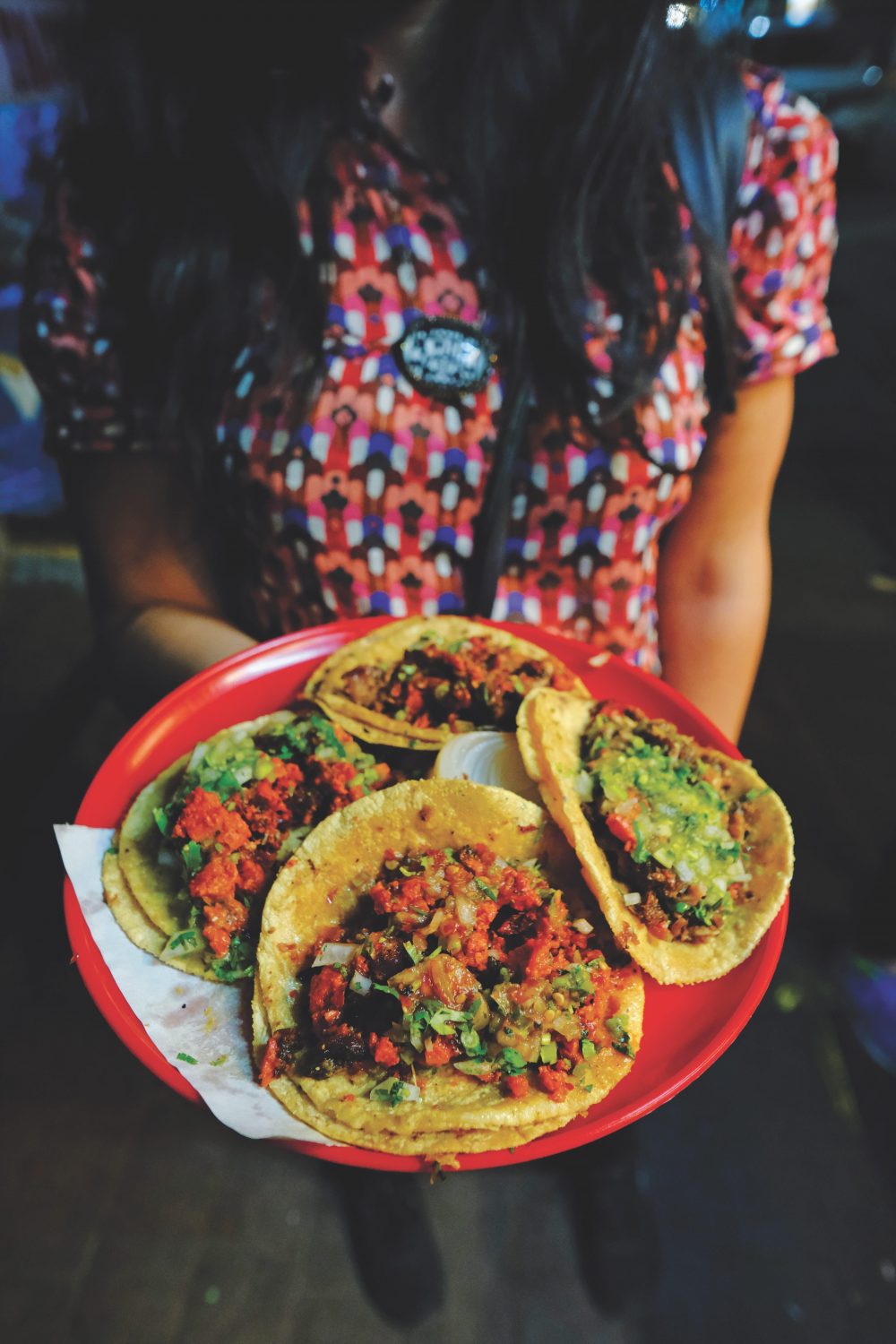
The cacophony of grinding stone, churning blades and clacking steel conveyor belt is intense, echoing in the mostly windowless concrete room of green walls dusted yellow-white with corn flour. But not nearly so intense as the heat, rolling off Salvador Ledezma’s máquina tortilladora in waves so intense my iPhone shuts down.
Waves so intense, bone-in chicken parts, sopped with spice and oil, sizzle directly on the metal hull of the 12-foot-long tortilla maker, no pan needed. The room fills with the aroma of roasting meat mingling with the warm sweetness of fresh corn tortillas rolling off that belt, puffed, tender and barely browned in spots.
It’s Tortilleria Nelly, a tiny tortilla shop started almost 100 years ago by Ledezma’s grandfather in Plaza de Romita, a quiet Mexico City square where centuries ago sinners begged for an easy death at the 16th-century church before being hanged from the cypress trees just outside. Today, Ledezma and his sister sell tortillas for 16 pesos (8 cents) a kilogram.
Ledezma grabs massive lumps of putty-like white masa, dumping the dough into a whirring hopper attached to the tortilla machine. It’s a 60-year-old, deviously hot rectangular device that kneads the masa, then rolls it flat between stones before cutting from it thin 6-inch rounds that drop to the conveyor.
From there, it’s a ponderous journey over concealed but intense flames that toast first one side, then the other as the tortillas flip and return to the far end of the machine. When man and machine are in sync, they can produce as many as 7,500 tortillas per hour, most to be sold from the doorway or delivered by bicycle to nearby street vendors and homes.
I’d come to Mexico City to learn about its tacos, a food ubiquitous to Mexico but revered in the capital, where street vendors ply innumerable varieties from dawn well into dark. And Ledezma quickly illustrates how little I know. Pulling a fresh tortilla from a stack, he sprinkles it with salt, folds it in half, tilts his head to the side and devours it in two quick, satisfying bites.
That’s a taco, he explains. Wait... What? Isn’t that just a... soft tortilla chip?
So is this, he adds, grabbing another tortilla and using it to pull hunks of meat from the chicken that was cooked on the tortilla maker. He spoons a thick, deeply charred, almost black salsa over it, then repeats the fold-tilt-eat maneuver. “It tastes of Mexico,” he says. “The corn, the soil, the families and memories.”
I follow his lead, repeating both of his tacos. The first is sublime in its simplicity, the essence of corn—warm, sweet and lingering—though it hardly seems a taco. The second is ridiculously satisfying, savory and spicy. Both are a long way from the crunchy taco “shells” stuffed with vaguely spiced ground beef, lettuce and watery tomato salsa I disliked as a child.
There were many lessons hidden in this exchange. The balance of flavors and textures. The importance of the tortilla itself. The interplay of fire and smoke. The role of dried chilies. Even the method of eating. But they’d only reveal themselves slowly as I spent the week scouring the city for great tacos. Clearly, I had much to learn.
Searching for Mexico City's Best Tacos
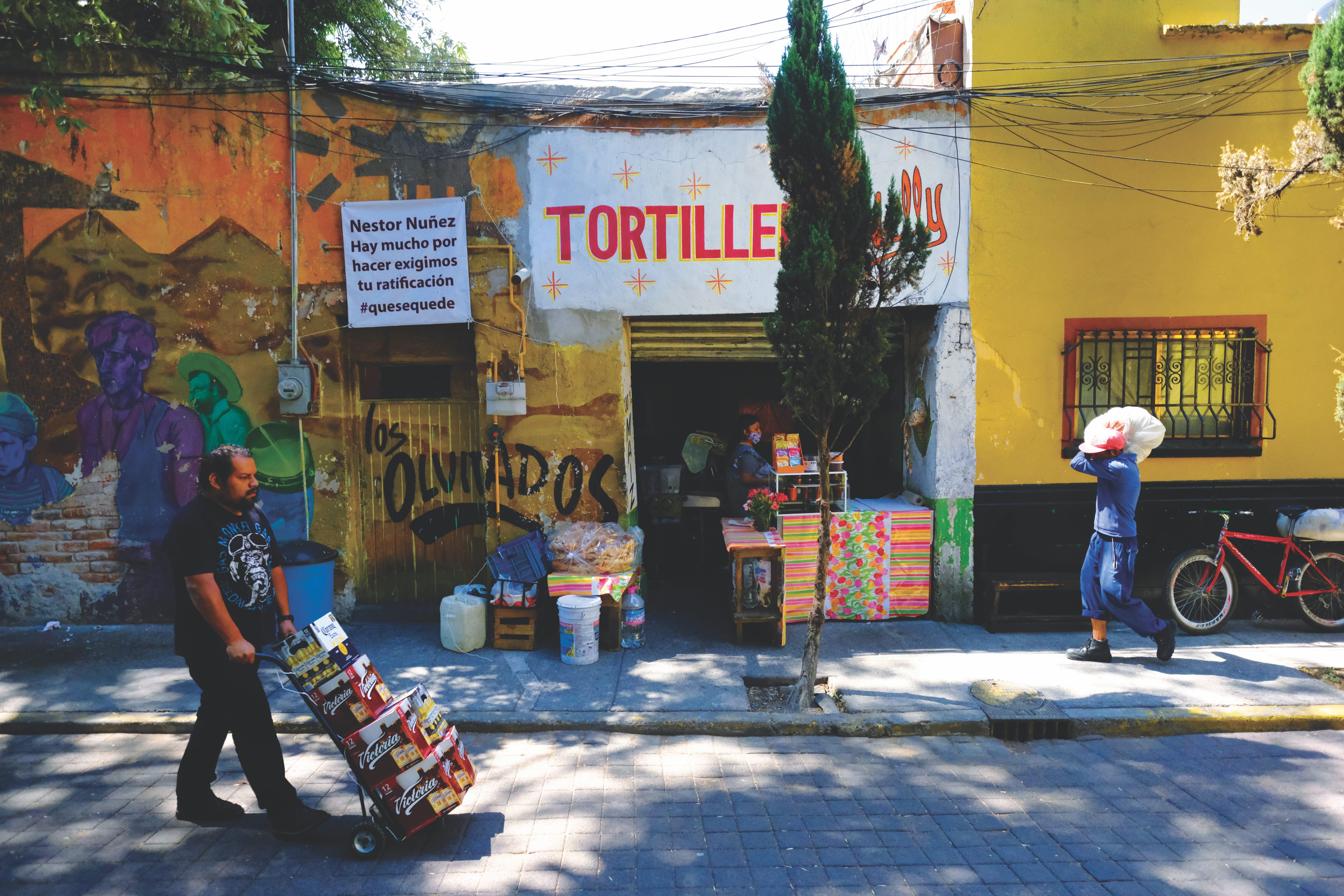
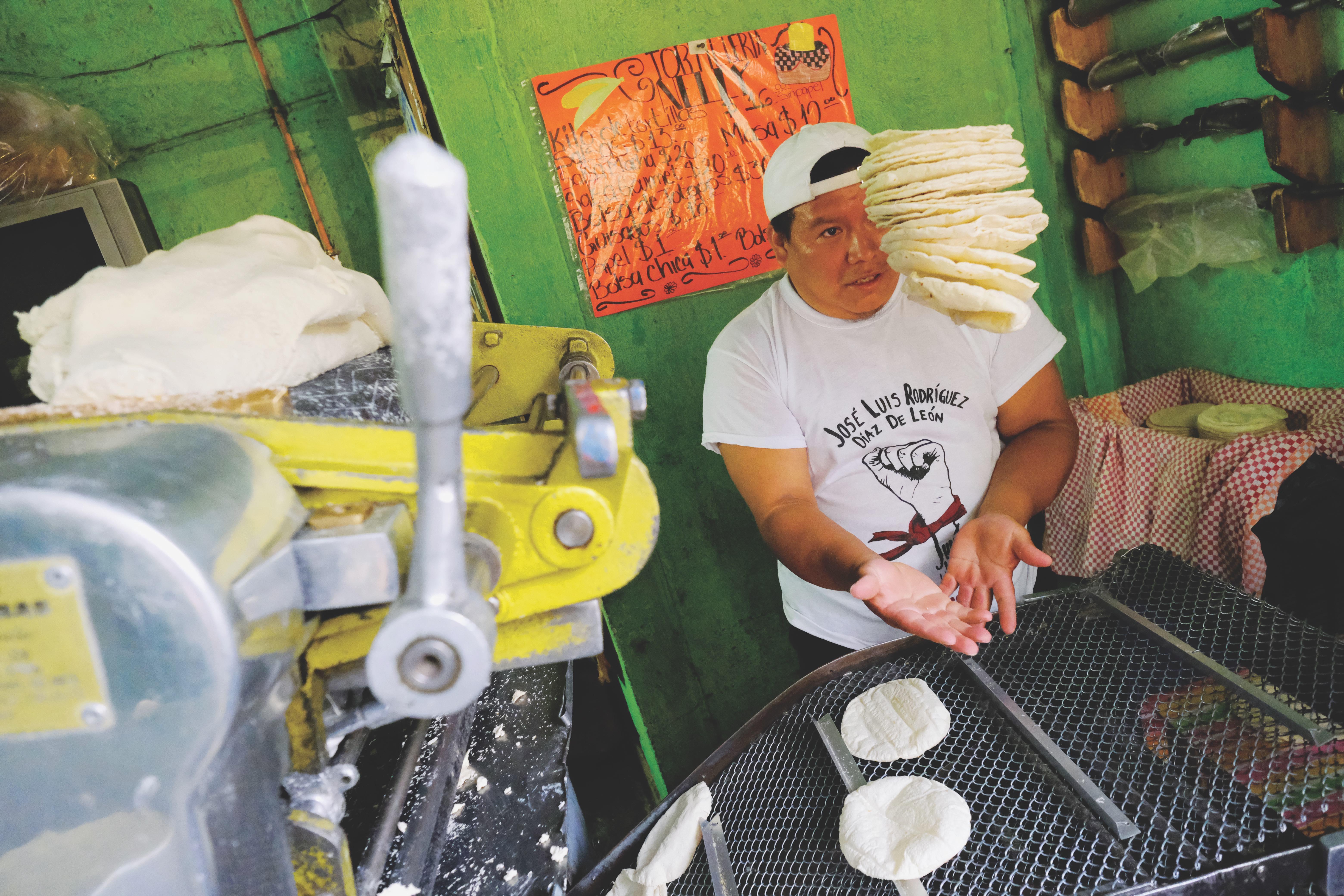
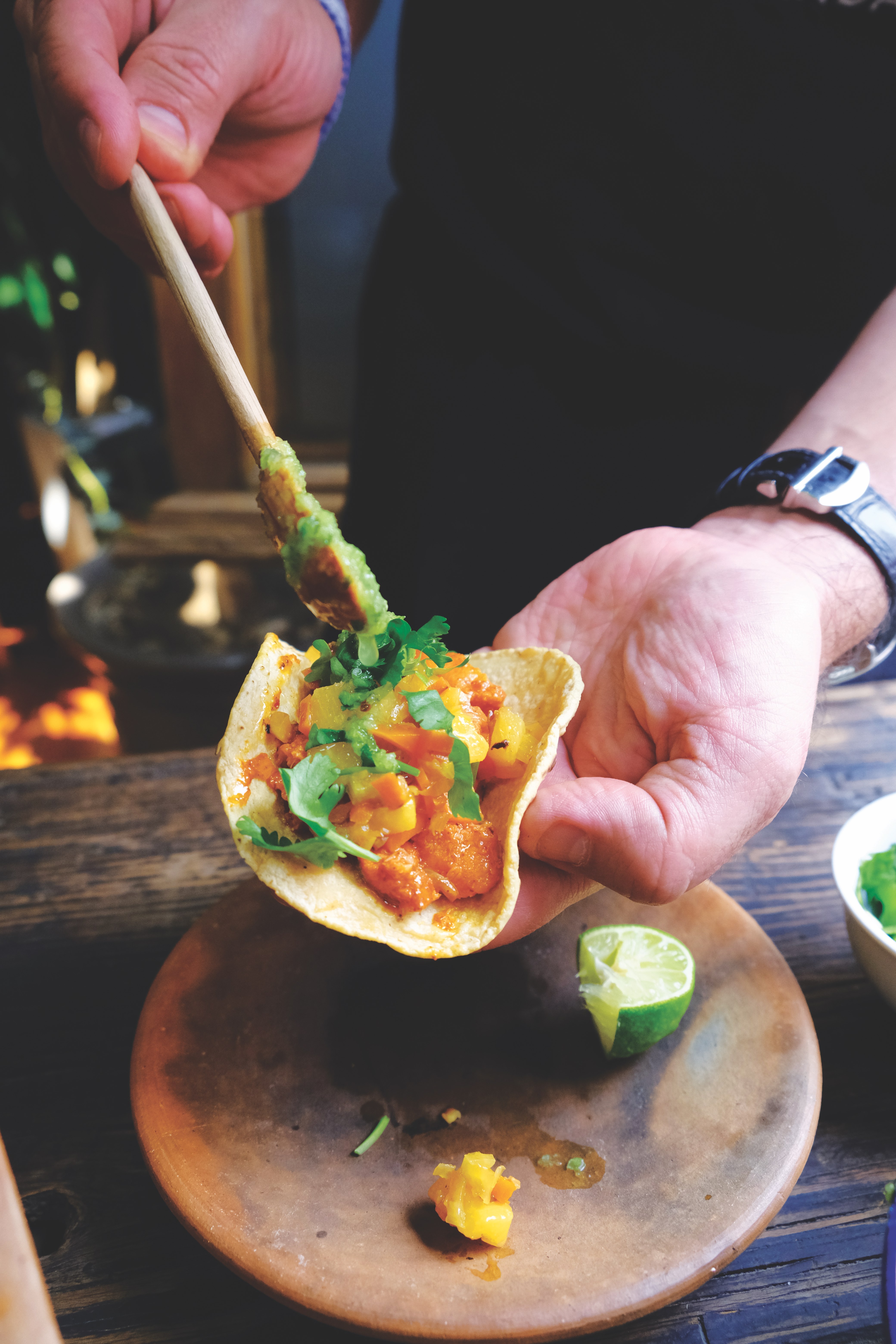
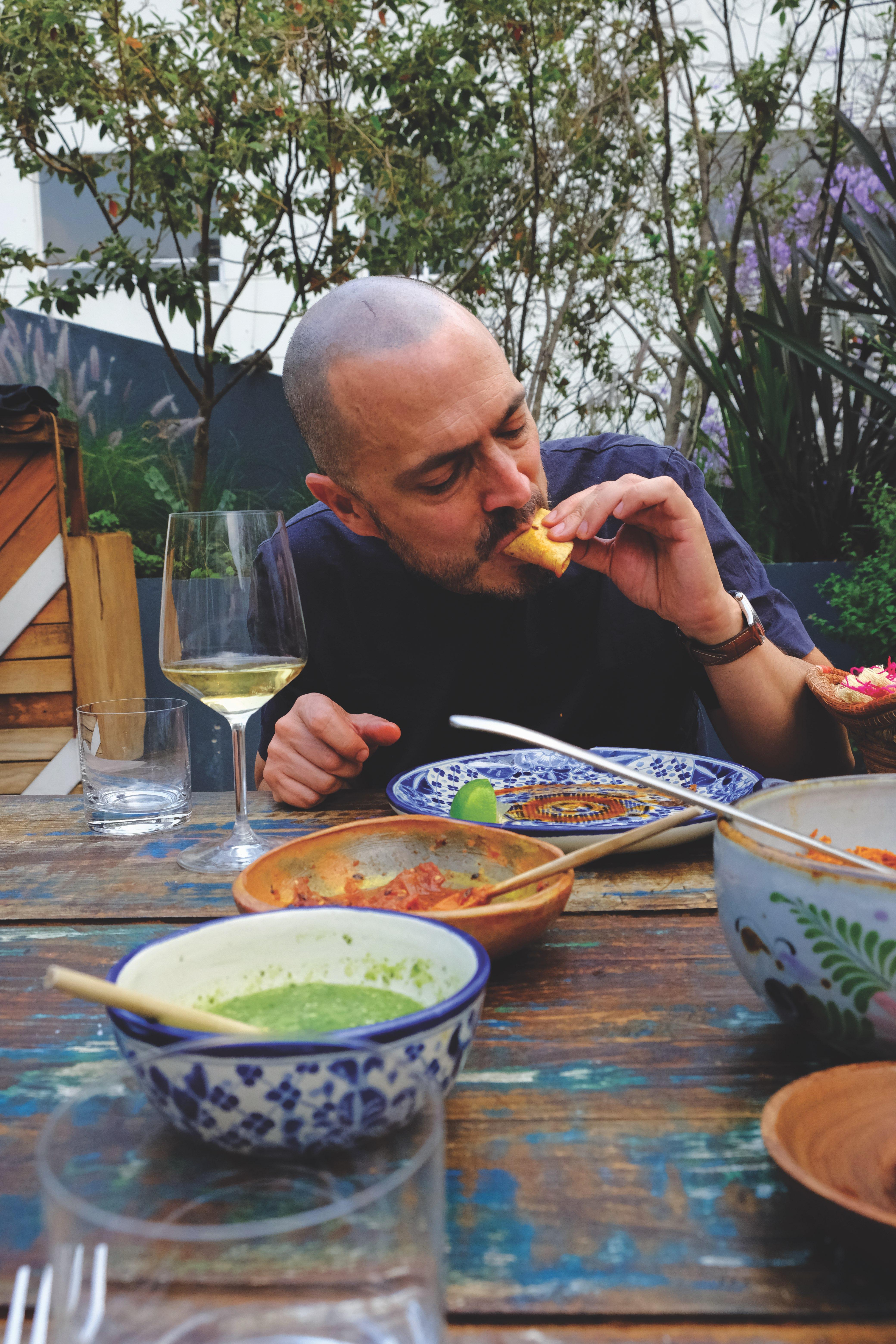
“You can make a taco with anything,” says María Ítaka, my translator. “If you have a tortilla and a filling, you have a taco.
The Corn
Some parts of the U.S. are lucky enough to have a true taco culture. Many are not, the only viable explanation for the sad state of the tacos many of us know. So an explanation is in order. The exact origins of the taco are debated, but most agree they date back in some form to Mexico’s pre-Hispanic period, when tortillas were used to scoop food.
The modern taco hit its stride in the early 20th century, when rural workers moved to the cities, especially Mexico City, bringing varied foodways and opening streetside stands to feed fellow migrants looking for a taste of home. Today, the city has nearly 20,000 taquerías, and one study found that almost nobody lives more than 400 meters from a taco stand.
But what is a taco? “You can make a taco with anything,” says María Ítaka, my translator. “If you have a tortilla and a filling, you have a taco. The moment you fold it up, that’s a taco.” That salt taco, for example. It’s Mexico’s answer to England’s beans on toast, or the United States’ cold breakfast cereal for dinner. And, of course, that’s just the start.
And it all begins with corn. Tougher and more flavorful than sweet American corn, Mexican corn must be soaked, then cooked in a lime solution. This process, called nixtamalization, plumps and tenderizes the kernels, rendering them digestible. They then are stoneground to form masa, a soft, moist dough that is easily shaped.
The smell of that dough—and tacos in Mexico City almost always are made with soft corn tortillas—flattened and cooked on griddles called comals, fills the city’s streets with toasted sweetness, mingling with sizzling meat, cilantro, pops of lime, all of it perfumed from jacaranda trees that canopy the streets with purple flowers that smell of honey, ivy and rain.
And it’s on those streets where my taco education begins in earnest.
The Method
Tacos can be a workout. To make his point, Ruben Orozco breaks the staccato of his knife chop-chop-chopping charred beef and chorizo on a well-grooved cutting board to hold up both hands. His right is significantly larger than the left. He has worked as a butcher since he was 8; he has run Tacos Ruben’s with his wife, son and daughter for 16 years.
His stand is parked on a sidewalk across from a gas station, a soccer match playing on a television hanging from the rafters of his canopy, a dozen people lined up waiting. The family works in unison to produce tacos suadero—citrus-marinated beef cooked with tripe in chorizo fat on a sombrero-shaped comal, or chorizera, finely chopped and slid onto double layered tortillas.
Onions, cilantro, lime. Four salsas of varying heats and complexions are holstered along the side of the stand for diners to help themselves. All of it, just a few pesos apiece. Handed one, I fold it and bring it to my mouth. Rich and meaty, bright, fruity and fresh. Wildly flavorful. Or at least the parts of it that don’t land on my shirt and shoes are.
That’s my next lesson. The contents of the taco may be flexible, but the art of eating it is more rigid. Orozco shakes his head at me. The taco does not come to you, he says. You go to the taco.
He grabs a taco suadero, pinching the tender corn tortilla closed with thumb and forefinger, pinkie extended. He tilts his head to the left, his open mouth now mimicking the shape of the taco, then—without moving his hand—brings his mouth to it, eating it in two generous bites. When he smiles, the crowd nods along. This is how you eat a taco, they agree.
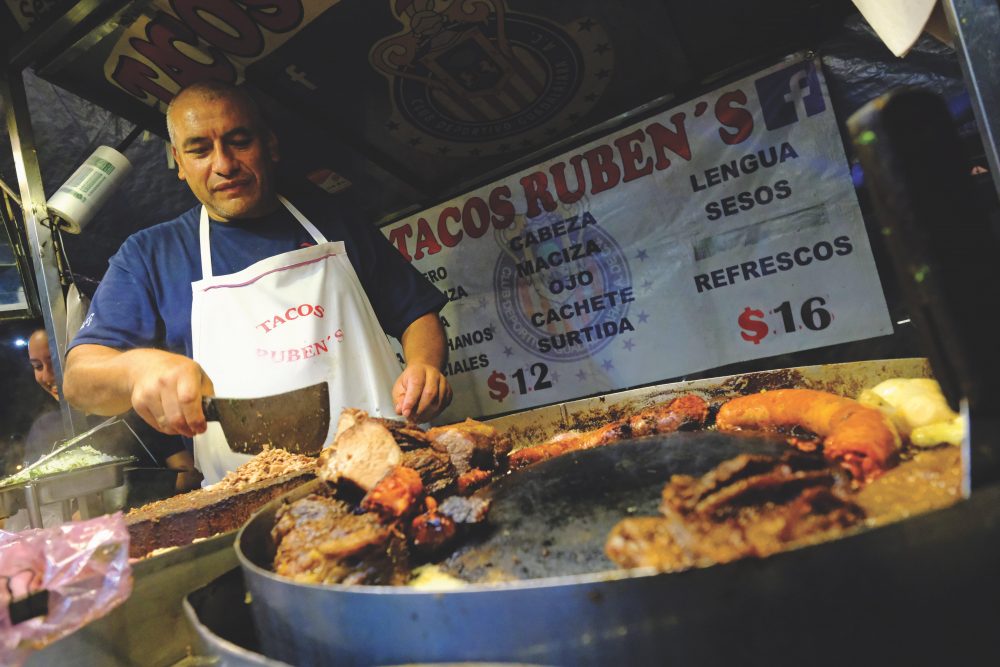
“All the tacos I make, I make as though I am going to eat them. When I make a taco, I’m already craving them,” Orozco says, patting his stomach.
The Flavors
Clear on what a taco is and how to eat it, I’m ready to cook one. My lessons begin in the sprawling, sunny kitchen of Jorge Fritz and Beto Estúa—charming husbands, designers and cooking instructors in the artsy Roma Norte neighborhood. The evening ends with enough mezcal to render my later notes less helpful than I’d like.
In between, there are tacos. So many tacos. We buy the tortillas from a vendor at the nearby market, allowing us to focus on the fillings. And here, no matter the protein, it is a lesson of contrasts. The backbone of nearly every taco I eat in Mexico City is a delicious flavor tug-of-war between bright citrus and earthy-fruity dried chilies.
We start with cochinita pibil, a pulled pork from the Yucatán—a mix of loin, shoulder and rib—cooked in a smooth sauce of sour orange juice, habanero chilies, red onion, earthy-peppery achiote paste (a blend of bold red achiote seeds and chilies), allspice and avocado leaves.
Traditional versions cook many hours, but Fritz and Estúa opt for the pressure cooker, readying the pork in under an hour. The meat then is fried in a skillet with more red onion. It’s a wonderful technique that allows the meat to first become fall-apart tender without drying out, then creating richness and texture from a speedy char.
Spooned onto warm corn tortillas—“Corn is at the center of our culture and heritage. It shaped us and who we are,” says Fritz. “Oh, and chilies!”—and topped with pickled red onions and a salsa of deeply charred chilies, garlic and onion, the tacos are bright, tangy and porky, at once warm and citrusy. So many layers.
Next, fish tacos, too often a fried mess in the U.S. In Fritz and Estúa’s hands, they contain tender, brightly seasoned mounds of red snapper chunks marinated in a puree of orange juice, white onion, leathery guajillo chillies, oregano, cumin and achiote paste. The fish cooks in minutes, staying tender and juicy.
But the magic is in the toppings. This is where we so often get it wrong. Great tacos are about balancing taste and texture.
So to balance all the richness, we make a quick pickle of diced carrots, celery, onion and pineapple that is cooked until the liquid is pulled out, then evaporates, the sugars left behind caramelizing and thickening. It is tangy and sweet and a little chewy. Paired with a salsa fresca of pureed tomatillos, white onion and serrano chilies, the result is a riot of fresh citrus balancing chili-savory snapper, all tucked in a warm, pillowy soft-sweet tortilla.
With both tacos, there is so much happening, so many flavors and textures to tease out, you hope there never is a last bite. And in each case, it’s that same signature push-pull of bright citrus balancing fruity-earthy dried chilies.
The Char
“We call it salsa tatemada, or charred salsa. Mexican cooking is all about smoke and fire,” Josefina López Méndez, executive chef at the airy-modern Chapulín restaurant—where traditional Mexican cooking is given a modern nod—says as she blackens chilies and onions far beyond the stage I’d consider edible.
All the lessons I’ve amassed—the centrality of the corn tortilla, the flexible notion of taco, the importance of balancing contrasting flavors and textures, even the method of eating them—assemble here, but Méndez has another. Understanding tacos—in fact, understanding Mexican cooking broadly—requires embracing char.
Today, she cooks outside in the courtyard kitchen of a friend, a tiny stovetop in a terra-cotta alcove surrounded by a purple explosion of jacaranda flowers. We begin with salsa de habanero tatemado. A copious handful of habaneros, a hunk of white onion, garlic cloves, all toasting in a dry skillet until they crackle, potato chip-crisp, the air filling with spice.
It all lands in a molcajete, the rough lava stone mortar and pestle used to make Mexican salsas and dips. She grinds it all with lime juice and salt, quickly rendering it a loose paste. I’m not a fan of burnt, so I expect to not appreciate it. Quite the contrary. The flavor is amazing and not nearly as spiced as you’d think. The flame and citrus tamed the chillies. The char is rich.
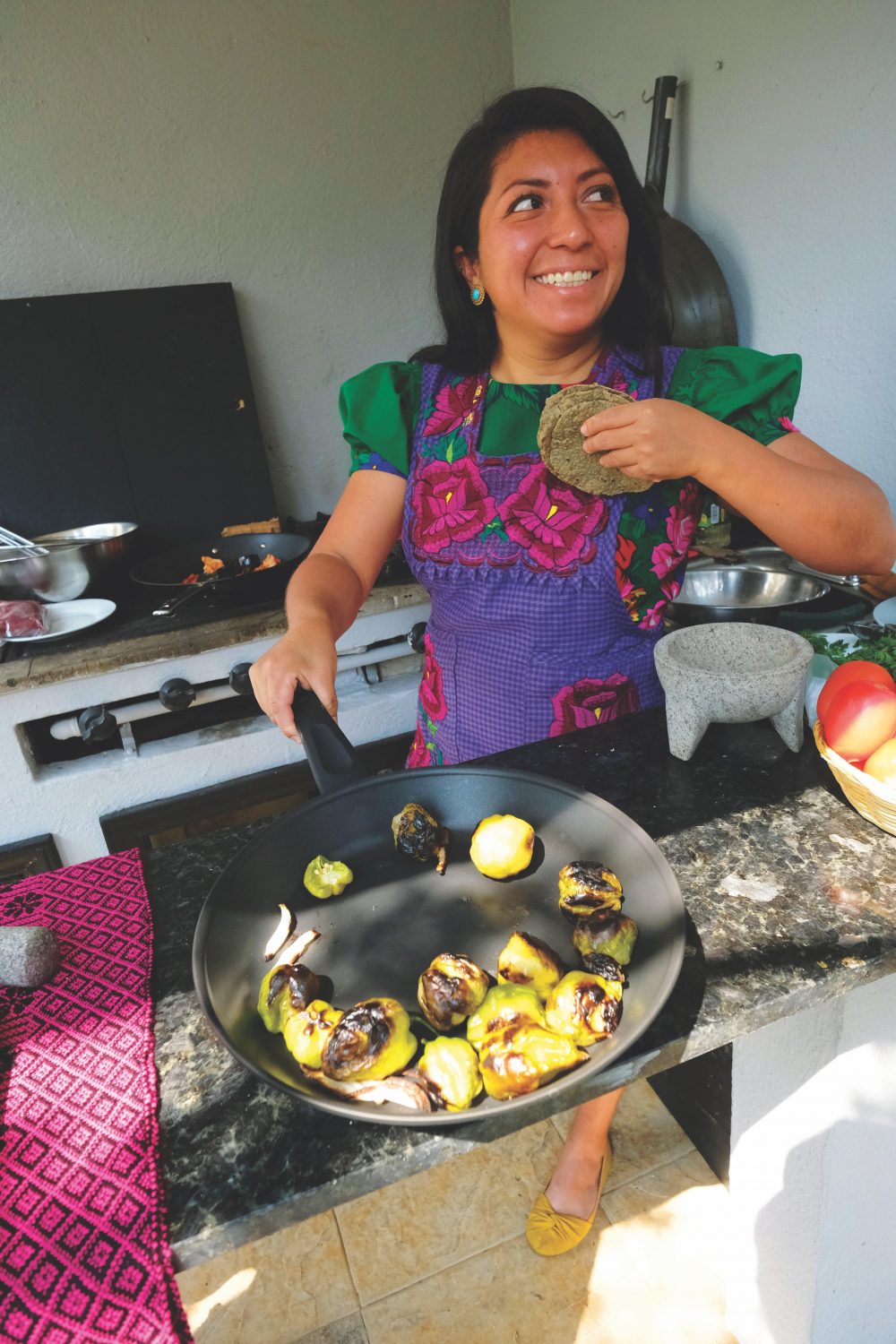
With the salsa set, Méndez—who learned her recipes from her mother and grandmother—assembles tacos gobernador, shrimp tacos supposedly created 30 or so years ago by a restaurant hoping to impress a Mexican governor. It’s an unusual combination of shrimp, tomatoes and mozzarella-like quesillo cheese. It’s as delicious as it is simple.
Tomatoes and onions cook in a skillet until they char just a bit, then break down. Plump raw shrimp are tossed in, cooking mostly in the residual heat of the vegetables. Meanwhile, Méndez sprinkles shredded cheese onto the top of a tortilla, then quickly flips it cheese side down into a hot skillet, rubbing it around until the cheese melts and browns in spots.
With a quick flip, she overturns the tortilla, the cheese now a delicious sticky mess, then spoons the shrimp mixture onto it. Little to no seasoning is needed—that comes from the salsa. The finished taco is amazing. Spicy and jammy, briny with plump shrimp, creamy and rich with toasted cheese. And it all took roughly 20 minutes.
The Chilies
It takes just a little prodding and only slightly more tequila to persuade Fernando Gonzalez to sing “Contigo Aprendí” for us, his voice lilting and reverberating off the stone walls around us. It’s the song—with lyrics of learning how deep and sweet a kiss can be—with which he wooed his girlfriend, Aidee Gonzalez, of almost 20 years.
She won him with her cooking. And as the table fills with tortillas, mounds of avocado, salsas, carne en su jugo (literally “meat in its juice”), beers, tequila, addictive fried chilies called chili chicharrones (named for the fried pork rinds often crumbled over tacos), and birria, a beefy taco filling jammed with chilies, it’s easy to see and taste the love.
Gonzalez starts by seeding and lightly toasting first guajillo chilies, then cascabel chilies, then an ancho chili, then morita chilies, all of them dried, leathery and a dark umber. Once toasted, they go into a blender along with garlic, allspice, cumin, bay leaves, thyme, cardamom and ginger. A bit of salt and water, then pureed until slightly thinner than tomato paste.
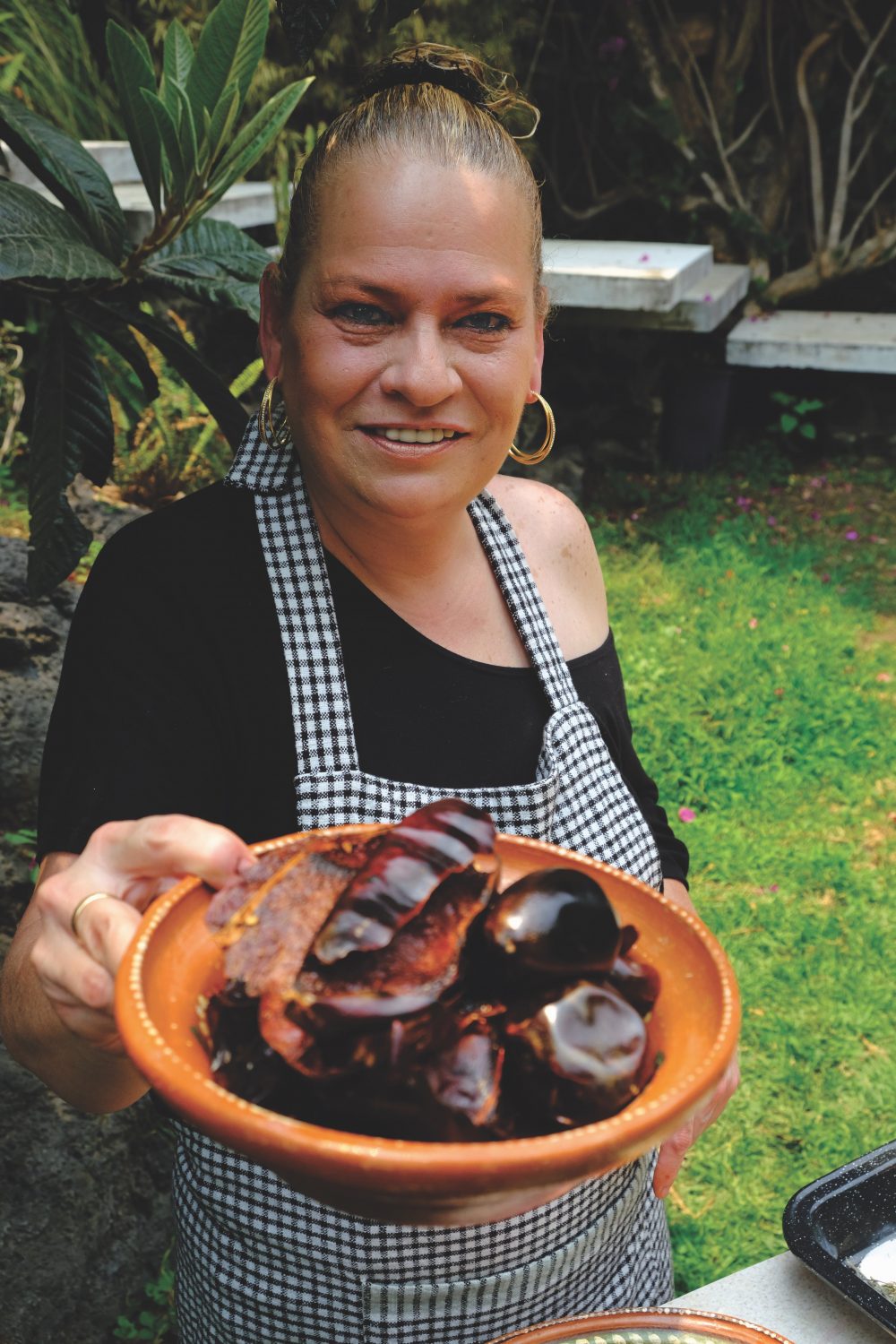
With all those chilies, I expect searing heat. But when I taste the mixture, it’s fruity and warm. Spiced, yes. But not so spicy. It has a depth and richness that is shockingly good. The mixture is poured over beef chunks, which she places in a Dutch oven to cook low and slow for several hours, sealing the pot with a thin strip of masa dough to keep the moisture inside.
When it emerges and joins our crowded table, we mound the fall-apart meat on tortillas with slices of white onion, avocado and salsa. The result is simply ridiculously good. Beefy, fruity, savory and tender, with spikes of heat from the salsa and creaminess from the avocado.
And that is my final lesson from this trip. Too often, we have too narrow a concept of chili flavor. We think chilies are about heat. Sometimes, sure. But mostly, they are about flavor. Fruity, smoky, aromatic. In Mexico, chili spice is a far more nuanced concept than many of us assume.
And now it’s my turn to fall in love. With real tacos. Every which way.
